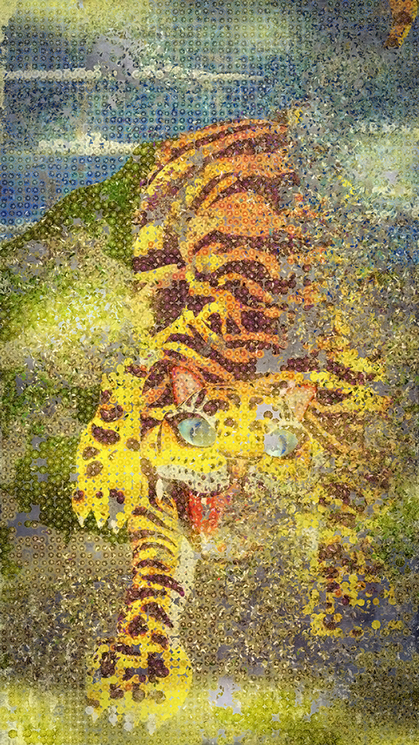-
From Current Issue
-
- Editor’s Letter Fire in the Heart
- Reviews I Gusti Ayu Kadek Murniasih
- Reviews 11th Seoul Mediacity Biennale: “One Escape at a Time”
- Dispatch Networked China
- One on One Monira Al Qadiri on Yukio Mishima
- Essays The rise of independent art spaces in pandemic-era Shanghai
- Features Tuan Andrew Nguyen
- Table of Contents
- Web Exclusives
- Archive
- Subscribe

R
E
V N
E
X
T
TeamLab, Flower Forest: Lost, Immersed and Reborn, 2017, interactive digital installation with sound by Hideaki Takahashi, dimensions variable. Courtesy the artists and Pace Beijing.
Can art—specifically, digital art—effectively raise awareness about our environment? TeamLab’s “Living Digital Forest and Future Park” at Pace Beijing attempted to do so, and their dazzling presentation attracted long queues at the gallery’s doors. Around the world, the Japanese multi-disciplinary art collective has several shows running concurrently, confirming that its focus on digital art and connection to nature is a winning formula in the art world’s current climate. Their selection of works not only appeases a younger generation hungry for entertainment, the group also offers depth and substance by drawing on ancient Japanese culture and aesthetics, alluding to connectivity between humans and the environment, as well as relations that link fellow visitors. In addition, a large portion of the exhibition space was devoted to the youngest audience members, featuring playful interactive digital games and activities.
TeamLab was founded in Tokyo in 2001 by Toshiyuki Inoko, who sees many advantages in the employment of digital art. For one, it provides more freedom for visual expression, and is less static than traditional media. The group developed the concept of “ultrasubjective space,” which stands in contrast to the Western linear perspective, where objects recede into the distance. Their idea is grounded in portrayals of space found in premodern Japanese painting, which has no single perspective. Those viewing a painting can be looking at the same vista as the subject depicted. Whereas the viewer never enters the reality of the painting under the Western mode, the Japanese tradition that teamLab models their scenes after places the audience in a new world, meaning that the audience can move freely within the art, and experience some works from multiple perspectives. This also underlines the traditional Japanese theory that we are not merely observers of nature but part of it.
Upon entering Flower Forest: Lost, Immersed and Reborn (2017), we find ourselves in a darkened room, surrounded by digital images of flowers of various shapes and colors on all walls, as well as on the ground. It is an interactive digital installation, so any movement within the work affects how it unfolds further, creating unique, one-off arrangements. For example, if we stay in one spot for an extended period, flowers bud, grow and bloom in a cluster around us. In contrast, if we touch or step on any of the flowers, they slowly wilt and die. There are no reoccurring images—this work is not a prerecorded animation, nor is it on loop—as these flowers are generated by a computer program that modifies images in real time. The distinguishing feature of this work, however, is not visual: Our actions influence how fellow onlookers see or experience the work. TeamLab strongly believes in interactive art as well as the positive relationships that can be shared by those viewing—experiencing—their art. As participants manipulate the artwork via their presence, they create matchless situations for the next visitor, who in turn does the same for those joining later. Crystal Universe (2015), an interactive work made from dots of light, offers even further opportunities for intervention. Here, in addition to our motions, we can manipulate the “light sculpture” via a downloadable smartphone app.
The theme of nature takes center stage in works from the “Fleeting Flower Series” (2017), such as Chrysanthemum Tiger (2017), which debuted in Beijing. In this work, as flowers bloom, a tiger’s image slowly materializes. However, as the life cycles of these flowers near their ends, and the petals fall from their stems, the striped cat also disappears. This single-channel digital work serves as a reminder that flora and fauna are interdependent and that there is a positive correlation between the health of our physical environment and that of the animal world. In their five-channel Universe of Water Particles – Gold (2016), a virtual waterfall, teamLab extends this idea of oneness with nature to that of the human world, stating, “If we regard ourselves as part of nature, and consider nature as something not just to be observed, it is possible to feel that there is no boundary between ourselves and nature.”
The influence of ancient Japanese culture is palpable in the aforementioned work, as well as the nearly 20-minute-long animation loop Ensō (2017). The digital cascade is based on the spatial conception in premodern Japanese paintings, where multiple lines are used to create the effect of animation. Ensō is inspired by the ancient spiritual Zen practice of drawing a circle in a single sweep, which is part of Japanese ink wash tradition. This work is concerned with “spatial calligraphy,” where the calligraphic rendering of a circle is suspended in mid-air and viewed in a simulated three-dimensional perspective.
In teamLab’s interactive show, we were no longer mere bystanders, but active collaborators and agents of change within the artworks—just as we are not merely observers of our environment. Our actions, deliberate or not, shape the conditions in our surroundings, as well as the experiences of our fellow humans.
TeamLab’s “Living Digital Forest and Future Park” is on view at Pace Beijing until October 10, 2017.
To read more of ArtAsiaPacific’s articles, visit our Digital Library.






